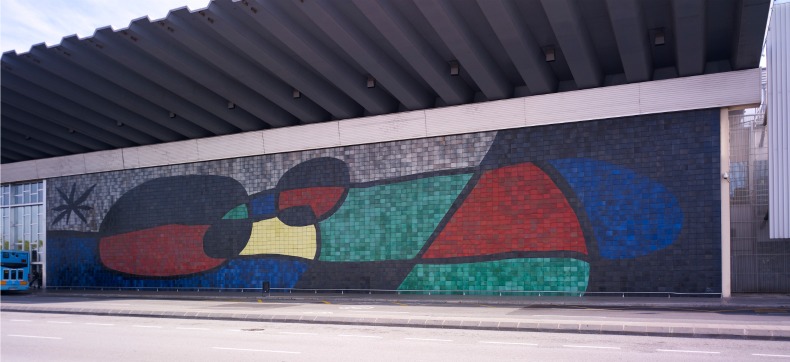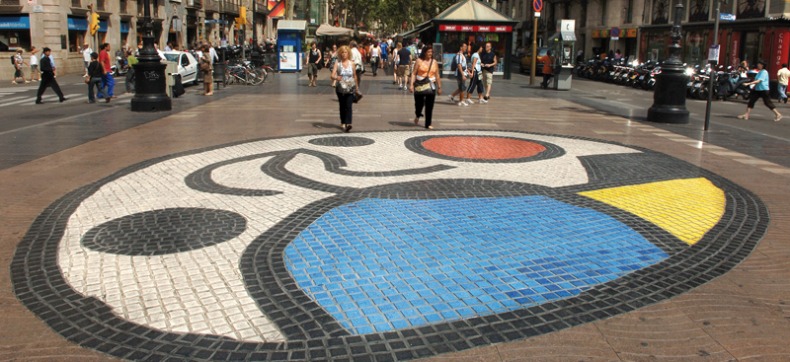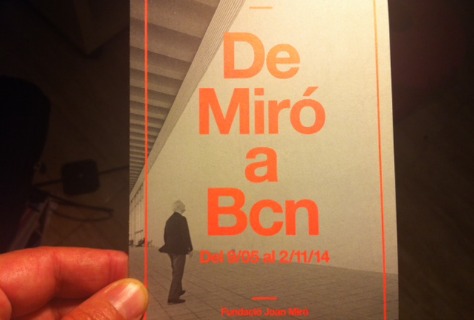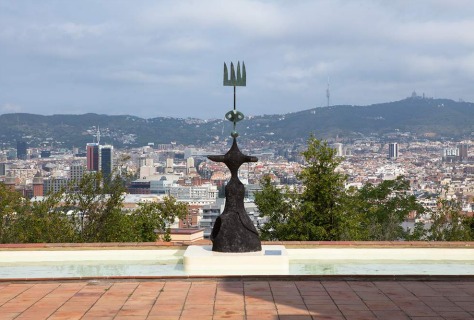10.05.2014 - 10:42
The image from the “From Miró to Barcelona” is a photograph by Francesc Català-Roca in which you can see Joan Miró in front of a huge white wall. Miró is studying the wall, curious, perhaps out of respect for its size (50 meters long and 10 meters high). It is the principal façade of the Barcelona airport in 1968 where later a Miró mural will be installed that will welcome passengers arriving in Barcelona. Miró donated that work to the city.
The airport mural, that Miró created in collaboration with ceramicist Josep Llorens Artigas and his son Gardy Artigas, takes up 500 square meters of surface space. They had to do 464 firings, all with wood-fired kilns, to create the 4,864 ceramic tiles that cover the surface. It was inaugurated on March 18, 1971 without the presence of the artist, who refused to play along with the Francoist authorities.
A few days later, on March 21, a report about the airport mural appeared on the front page of La Vanguardia, along with an even more important bit of news: the announcement that Miró would make four donations to the city. The story goes that journalist Lluís Permanyer had inteviewed Joan Miró about the work at the airport. Once the article was written, he sent it to Miró so that he could check it over, to make sure there were no mistakes. But Miró sent it back with a hand written note with the title “My proposal for Barcelona, as a personal donation”. And that was followed by a list:
A. A mural for the airport for those who arrive by air.
B. A 30-meter high sculpture for Cervantes Park for those who arrive by land.
C. A pavement on the Rambla for those who come by sea.
D. The Joan Miró CEAC Study Center for Contemporary Art, as an open door to the future, for international cultural exchange, with my absolute faith that Catalonia will have a huge role to play in the world of tomorrow.
Rosa Maria Malet, director of the Fundació Miró and commissioner of the “From Miró to Barcelona” exhibit, points out the concern that Miró had that art could live naturally side by side with the daily life of the people and the city. And the importance of work in collaboration with other artists: Josep Lluís Sert, Llorenç Artigas, etc.
The pavement on the Rambla turned into the mosaic called “Pla de l’Os” (The plain of the bear). The thirty-meter high sculpture that Miró imagined for the Parc Cervantes was never placed, but it was created: it’s called Miss Chicago, because it ended up being an assignment for the city of Chicago in the United States. However, there was a preparatory study, a mock up of smaller size, that was shown for the first time in the great exhibit of 1968 dedicated to Miró in the Antic Hospital de la Santa Creu. Miró gave it to Pierre Matisse and later Matisse gave it to the Miró Foundation, when it was inaugurated. Today the piece is installed in the northern patio of the foundation’s museum.
The current exhibit is centered around these four Mironian pillars of the city, the four donations that he wished to make to Barcelona. In addition, “From Miró to Barcelona” also initiates a new exhibit cycle, “Miró: Documents” dedicated to reviewing the artist’s work using the documents and works of arts at the Foundation.
“From Miró to Barcelona” is a small format proposal that is taking place at the Emili Fernández Miró gallery. The space is intimate and the designer Lluís Pau has given it a circular form with the Josep Lluís Sert-designed Fundació Miró building as its central focal point. There are preparatory studies, models, and letters that describe Miró’s process, context, and viewpoints for each project. There is also a later work that was inaugurated just before the artist’s death, the “Dona i ocell” (Woman and Bird) sculpture in the Parc de l’Escorxador.
One of the important contributions that the exhibit makes is the rediscovery of a film by Francesc Català-Roca about the creation of the airport mural with never-before seen images thankfully preserved by the Filmoteca, Catalonia’s film repository. The images reveal the creative force of the artists involved. You can see Miró, Llorenc Artigas and Gardy Artigas seated in cane chairs talking about how they’re going to make the mural. Miró shows such character and determination!
Rosa Maria Malet points out how Miró’s work ties into the artistic legacy that runs through the history of the city, and that we can find in Roman remains, Romanesque art, Gaudí and even today.
An app for mobile devices that includes a Miró Route through Barcelona compliments the exhibit.
“From Miró to Barcelona” runs until November 2. Entrance is free, as a way of illustrating Miró’s generosity with the city.






